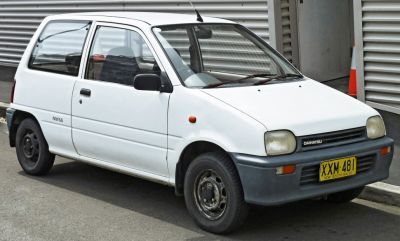 1992 Daihatsu Opti (L3) Dimensions, Size & Specs
1992 Daihatsu Opti (L3) Dimensions, Size & SpecsMeasurements of the 1992 Daihatsu Opti, engineered for optimal performance and comfort
| Dimensions | |
|---|---|
| Length: | 3295 mm129.7 in10.8 ft |
| Width: | 1395 mm54.9 in4.6 ft |
| Height: | 1395 mm54.9 in4.6 ft |
| Weight Specifications | |
| Curb Weight: | 670 kg1477 lbs |
| Tire Specifications | |
| Tire Size: |
|
The Daihatsu Opti (L3) is a compact hatchback produced between 1992 and 1998, representing a practical and efficient urban vehicle from the early 1990s. With a length of 3295 mm (approximately 129.7 inches or 10.8 feet), a width of 1395 mm (54.9 inches or 4.6 feet), and a height of 1395 mm (54.9 inches or 4.6 feet), the Opti (L3) stands out for its small footprint, making it ideal for city driving and tight parking spaces. The vehicle's curb weight is a light 670 kg (1477 lbs), which contributes to its fuel efficiency and nimble handling characteristics. Equipped with 145/65 R13 tires, the Opti offers a balanced ride with good grip for a car in its segment and era. Its compact dimensions and low weight reflect Daihatsu’s focus on producing economical and practical kei cars, which adhere to the regulations favoring smaller vehicles in Japan. The hatchback design adds versatility, providing practical cargo space relative to its size. Overall, the Daihatsu Opti (L3) delivers an economical and space-efficient solution well-suited for urban commuters and those seeking a dependable small vehicle with modest size and good maneuverability.
Discover the standout features that make the 1992 Daihatsu Opti a leader in its class
Have a question? Please check our knowledgebase first.
The Daihatsu Opti (L3) hatchback from 1992 to 1998 has a compact size, making it ideal for city driving. Its length measures 3295 mm (approximately 129.7 inches), width is 1395 mm (about 54.9 inches), and height is 1395 mm (also approximately 54.9 inches). These dimensions contribute to its efficiently small footprint, allowing easy maneuverability and convenient parking in tight urban environments.
The curb weight of the Daihatsu Opti (L3) is 670 kg (or about 1477 lbs). This lightweight design helps improve fuel efficiency since the engine has less mass to propel, leading to lower fuel consumption typical of kei cars in Japan. Moreover, the lighter weight positively impacts handling, making the car agile and responsive, especially in urban settings or tight spaces.
The Daihatsu Opti (L3) is equipped with tires sized 145/65 R13. This relatively narrow tire width and smaller rim diameter reflect its lightweight and compact design, which maximize fuel economy and reduce rolling resistance. Compared to typical subcompact or compact cars, these tire dimensions are smaller but balanced to maintain adequate grip and ride comfort for city driving.
Yes, the Daihatsu Opti (L3) fits easily into a standard residential garage. With a length of 3295 mm (129.7 inches or about 2.95 meters) and a width of 1395 mm (54.9 inches or 1.395 meters), it is smaller than most compact cars. Standard garages, which typically accommodate vehicles up to around 6 meters in length and 2.5 meters in width, can easily house this kei car, leaving ample space for opening doors and storage.
The Daihatsu Opti was introduced in 1992 as a kei car replacement for smaller models such as the Daihatsu Mira. Compared to its predecessors, the Opti (L3) maintained similar kei car dimensions but featured a slightly more modern and refined design. Its compact dimensions remained within kei car regulations, focusing on maximizing interior space and efficiency in a small footprint. While specific predecessor model dimensions vary, the Opti improved in terms of modern styling and safety features, with the size remaining consistent for easy urban usability.
The Daihatsu Opti (L3) shares its compact dimensions typical of kei cars from the 1990s. Its length of 3295 mm and width of 1395 mm are close to the upper limits allowed by kei car regulations at the time, similar to rival kei cars like the Suzuki Alto or Honda Today. This makes the Opti competitive in offering maximum interior space while maintaining the small footprint necessary for Japanese urban and suburban roads. The height of 1395 mm also aligns closely with other models, striking a balance between headroom and aerodynamics.
Absolutely! With its compact length of just 3295 mm and narrow width of 1395 mm, the Daihatsu Opti (L3) is perfectly designed for city driving. Its small size makes parking in crowded areas easy and navigation through tight city streets effortless. The lightweight 670 kg curb weight enhances its agility and responsiveness. This kei car excels in urban environments where space is at a premium and tight turns are common.
The Daihatsu Opti (L3), being a kei car hatchback, typically seats up to four passengers with two in the front and two in the rear seats. Despite its compact outer dimensions, the Opti's interior design focuses on maximizing usable space. Its height of 1395 mm provides adequate headroom for occupants, and the hatchback layout allows for versatile cargo storage in the rear. While rear seat legroom is modest, it is suitable for short city trips and everyday errands.
The Daihatsu Opti (L3), produced from 1992 to 1998, introduced a more modern and boxy hatchback design that focused on urban practicality. It featured improved aerodynamics, a more spacious cabin relative to its kei car dimensions, and modern amenities typical of the era like improved suspension and safer braking systems. Compared to earlier Daihatsu kei models, the Opti was aimed at offering a balanced package of economy, comfort, and maneuverability.
Thanks to its lightweight of only 670 kg (1,477 lbs) and compact kei car engine, the Daihatsu Opti (L3) boasts excellent fuel efficiency, which was a key factor in its design. Its lightweight structure means the engine consumes less fuel during typical urban and suburban driving, making it economical for daily commuting. Furthermore, as a kei car, it complied with Japan’s strict regulations on emissions during its production years, ensuring it's an environmentally friendly option for the city driver prioritizing cost-effective and eco-conscious transportation.
Discover similar sized cars.

| Production: | 1990-1994 |
|---|---|
| Model Year: | 1990 |
| Length: | 3295 mm129.7 in |
| Width: | 1395 mm54.9 in |
| Height: | 1410 mm55.5 in |

| Production: | 1989-1998 |
|---|---|
| Model Year: | 1990 |
| Length: | 3290 mm129.5 in |
| Width: | 1395 mm54.9 in |
| Height: | 1400-1425 mm55.1-56.1 in |

| Production: | 1997-2008 |
|---|---|
| Model Year: | 1997 |
| Length: | 3200-3350 mm126.0-131.9 in |
| Width: | 1420 mm55.9 in |
| Height: | 1400-1415 mm55.1-55.7 in |

| Production: | 1992-1998 |
|---|---|
| Model Year: | 1992 |
| Length: | 3295 mm129.7 in |
| Width: | 1395 mm54.9 in |
| Height: | 1375-1385 mm54.1-54.5 in |
